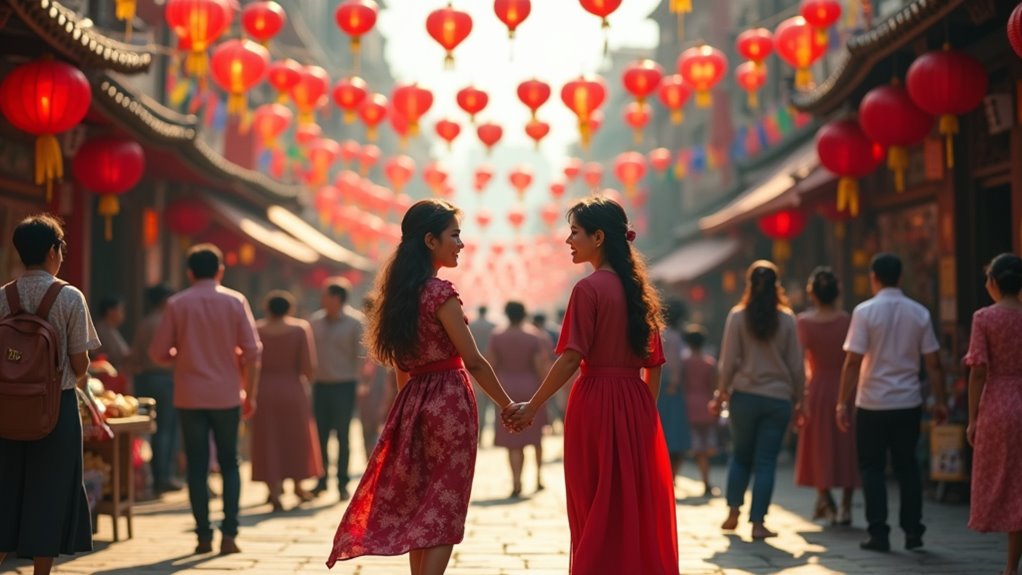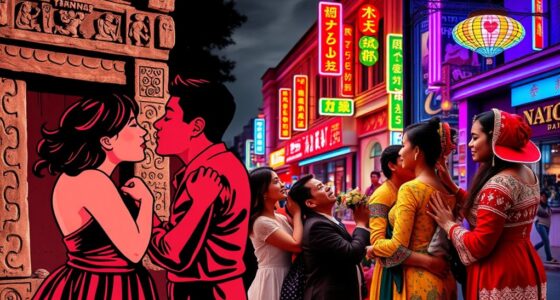As you explore Valentine’s Day traditions around the world, you’ll notice that many cultures have long held taboos about openly celebrating love. These restrictions often stem from deep-rooted religious, societal, or traditional beliefs that shaped how people express affection. But as norms evolve, attitudes are shifting. Understanding these changing perspectives reveals how love is increasingly embraced in new and diverse ways, challenging old restrictions that once seemed absolute.
Key Takeaways
- Many cultures historically viewed openly expressing love on Valentine’s Day as immoral or inappropriate due to religious and societal norms.
- Traditional gender roles and conservative values have limited public displays of affection and gift-giving during the holiday.
- Political regimes and religious authorities have often banned or restricted Valentine’s Day celebrations to preserve cultural or moral standards.
- Attitudes are shifting toward greater inclusivity, acceptance of diverse relationship types, and recognition of all love forms.
- Globalization and social media foster cross-cultural understanding, gradually reducing taboos and encouraging more open, diverse expressions of love.
Historical Roots of Valentine’s Day Taboos

The roots of Valentine’s Day taboos trace back to ancient customs and religious beliefs that have shaped attitudes toward love and morality. Ancient origins reveal that early societies assigned symbolic meanings to romantic gestures, often linking them to spiritual or moral codes. In some cultures, expressing love openly was seen as immoral or dangerous, leading to strict taboos. These symbolic meanings reflected societal values, emphasizing modesty, chastity, or spiritual purity. Over time, these beliefs transformed into cultural restrictions that influenced how people could celebrate or even acknowledge love publicly. Understanding these origins helps you see how historical perceptions continue to influence modern attitudes, even as many taboos weaken or shift today. Additionally, the enforcement of these taboos was often reinforced by religious doctrines, further embedding restrictions on love expressions within societal norms.
Religious and Cultural Restrictions Across Regions

Across different regions, religious and cultural beliefs substantially shape how Valentine’s Day is observed and what restrictions are in place. In some countries, cultural rituals emphasize modesty and family-centered celebrations, limiting public displays of affection or romantic gestures. Social stigmas also influence how openly you can express love, especially where conservative values dominate. For example, in certain regions, openly celebrating love may be seen as inappropriate or disrespectful to local customs. These beliefs create restrictions that guide behavior and shape societal expectations around the holiday. Recognizing these cultural and religious influences helps you understand why Valentine’s Day may be subdued or even suppressed in some areas, highlighting how deeply rooted traditions and social norms impact the way people observe or avoid the celebration altogether. Additionally, traditional cultural restrictions on expressions of romance often reinforce these attitudes, further limiting the ways couples can celebrate.
Gender Roles and Expectations Influencing Celebrations
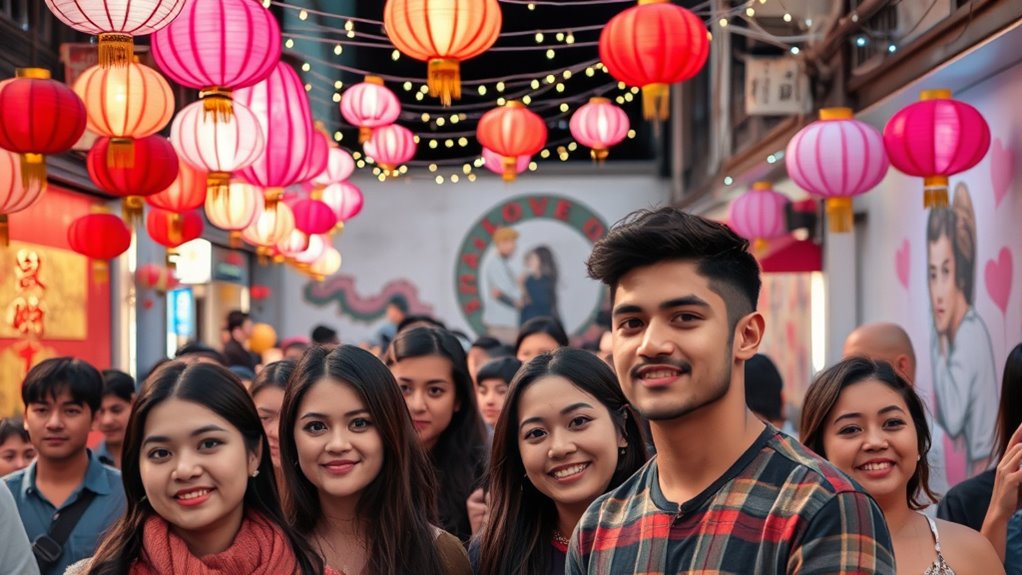
Your expectations around Valentine’s Day often reflect traditional gender roles, like men giving gifts and women receiving them. These stereotypes can shape how people celebrate and reinforce societal norms. By examining these patterns, you can better understand how gender influences romantic expressions across cultures. Additionally, evolving attitudes towards gender equality are gradually challenging these longstanding relationship stereotypes, leading to more diverse and personalized ways of celebrating love.
Traditional Gender Norms
How much do traditional gender norms shape the way people celebrate Valentine’s Day? Quite a bit, actually. Gender stereotypes often dictate what is considered appropriate for men and women during the holiday. Society’s expectations tend to assign specific roles—like men being expected to plan romantic gestures or give gifts, while women are seen as recipients or caretakers. These norms influence not only how you approach the day but also how others perceive your actions. You might feel pressured to conform to these stereotypes, even if your personal preferences differ. Over time, however, many are challenging these societal expectations, seeking more authentic expressions of love that aren’t confined by traditional gender roles. This shift is gradually transforming Valentine’s Day into a more inclusive celebration, as evolving attitudes promote gender role flexibility and individual expression.
Gift-Giving Expectations
Traditional gender norms also heavily influence gift-giving expectations on Valentine’s Day. You might feel pressured by commercial expectations to buy the perfect gift or to adhere to traditional gift etiquette. This can create stress around what’s appropriate or expected. To navigate this, consider these points:
- Recognize that gift-giving isn’t solely dictated by gender roles; focus on personal preferences.
- Avoid assuming that men should always give gifts, or that women should receive them.
- Communicate openly about expectations to reduce misunderstandings and align with both partners’ comfort levels.
- Keep in mind that cultural attitudes towards Valentine’s Day are evolving, leading to more flexible and personalized approaches to gift-giving.
Romantic Role Stereotypes
Romantic role stereotypes often shape how couples celebrate Valentine’s Day, with societal expectations dictating who should take on certain gestures or responsibilities. These gender expectations influence behaviors, like who plans surprises or gives gifts. You might feel pressured to conform to traditional roles, such as the man being the main provider of romance or the woman expecting thoughtful gestures. However, attitudes are shifting as more couples challenge these stereotypes. Recognizing that romantic stereotypes can limit genuine expression, you’re encouraged to define your own way of celebrating. Below is a table highlighting typical gender expectations versus evolving attitudes:
| Traditional Gender Expectations | Common Romantic Stereotypes | Changing Perspectives |
|---|---|---|
| Men plan surprises | Women expect flowers | Couples share planning responsibilities |
| Women handle emotional gestures | Men give practical gifts | Both express affection openly |
| Men lead in romantic gestures | Women wait to be courted | Equality in expressing love |
Furthermore, understanding the underlying influences of cultural norms, such as Personality Test insights, can help individuals and couples navigate these evolving attitudes more authentically.
Legal and Political Opposition to Valentine’s Day
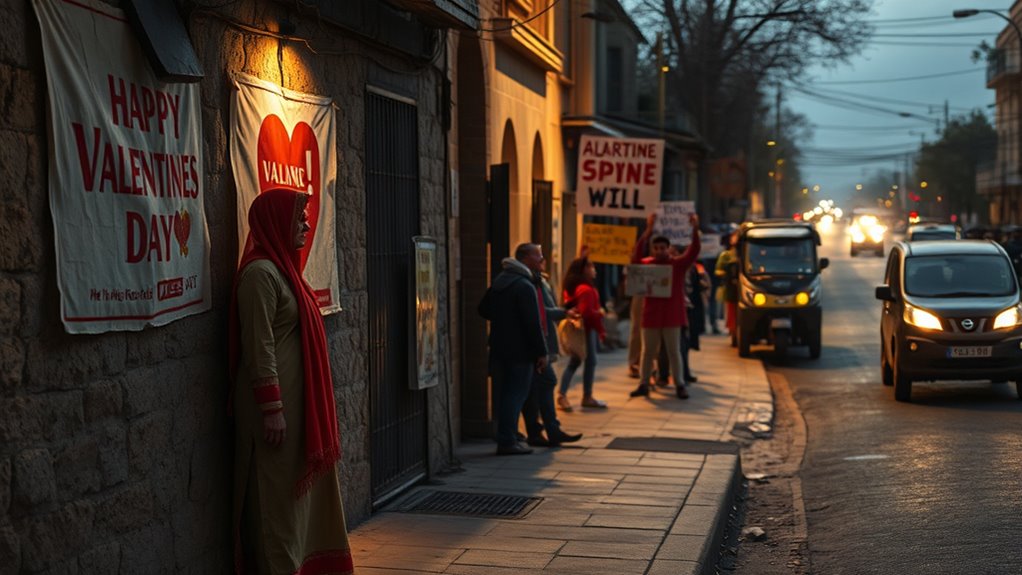
Throughout history, various governments and political groups have opposed Valentine’s Day, viewing it as a threat to their cultural or ideological agendas. They often impose legal restrictions or rally political opposition to suppress celebrations. For example:
- Some countries ban or restrict public displays of affection, citing moral or social concerns.
- Certain regimes label Valentine’s Day as a Western influence aiming to undermine local traditions.
- Political opposition may target the holiday to promote nationalistic values or control personal expressions of love.
- In some cases, efforts to regulate or restrict the holiday are linked to broader efforts to manage cultural influence and maintain ideological purity. Despite such restrictions, Valentine’s Day continues to spread globally, challenging political opposition and legal barriers that seek to limit its observance.
Shifts in Societal Attitudes and Modern Acceptance
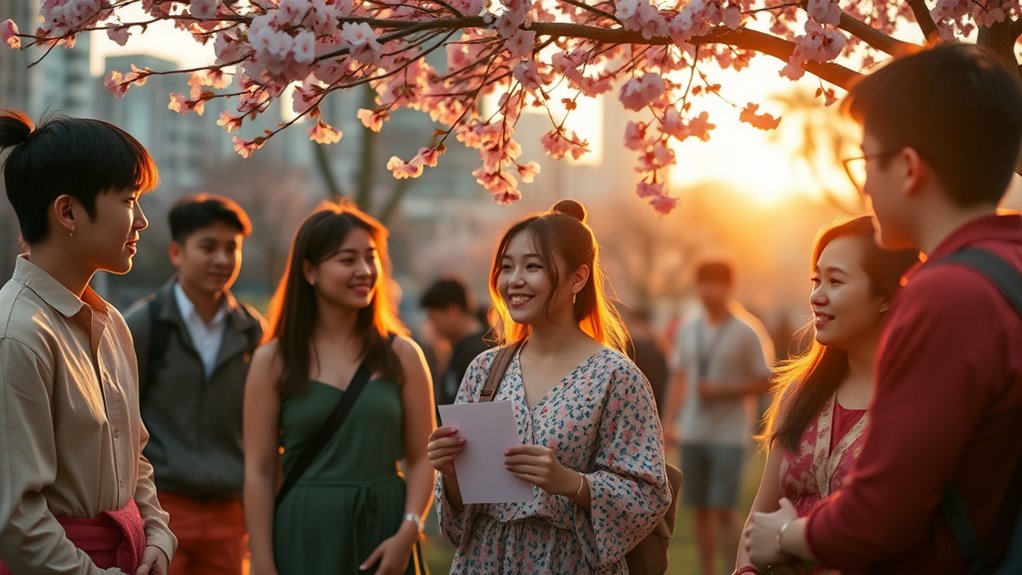
Despite past efforts by governments and political groups to suppress Valentine’s Day, societal attitudes have gradually shifted toward broader acceptance. Today, modern dating practices embrace diversity, making Valentine’s celebrations more inclusive. LGBTQ+ acceptance has grown, leading to greater visibility and recognition of same-sex relationships on this day. You’re more likely to see couples of all orientations openly expressing affection, challenging traditional norms. This change reflects a broader societal move toward understanding and respecting different love stories. People now view Valentine’s Day as a celebration of love in all its forms, rather than a restricted or taboo occasion. Additionally, advancements in AI Security contribute to fostering safer and more inclusive online spaces for diverse communities to express love openly. As acceptance continues to expand, the holiday’s cultural significance evolves, fostering a more inclusive environment where everyone feels free to celebrate love openly.
The Impact of Globalization and Digital Connectivity

Globalization and digital connectivity have profoundly transformed how people celebrate Valentine’s Day across the world. You now see diverse traditions blending, but this also brings risks like cross-cultural misunderstandings, where symbols or customs may be misinterpreted or offend. Additionally, online activism plays a role in challenging traditional taboos, sparking debates about appropriate expressions of love across cultures. To navigate this landscape, consider these points:
- Be aware of cultural differences when sharing Valentine’s Day content online.
- Recognize that social media amplifies voices, sometimes leading to misunderstandings or backlash.
- Understand that online activism can both challenge and reinforce taboos, shaping evolving attitudes.
- Being mindful of electric heated mattress pads and other comfort-related products demonstrates attention to personal well-being, which can be a considerate gesture in cross-cultural exchanges.
This interconnectedness helps foster greater understanding but also requires sensitivity to avoid unintentional offenses.
Frequently Asked Questions
How Do Different Cultures Define Appropriate Expressions of Love on Valentine’S Day?
You see that different cultures define appropriate expressions of love on Valentine’s Day through their unique cultural customs and traditional practices. In some places, couples exchange gifts or romantic notes, while others focus on family or community celebrations. These customs reflect local values and social norms, shaping how love is expressed. Over time, attitudes are evolving, allowing more diverse and personal expressions of affection, blending tradition with modern perspectives.
Are There Specific Age Groups More Likely to Face Valentine’S Day Restrictions?
Ever wonder who’s more likely to face Valentine’s Day restrictions? You might be surprised—teen restrictions often stem from family or societal rules about young love, while elderly attitudes can be more conservative or traditional. These age groups navigate different expectations, making Valentine’s Day a complex experience. Whether you’re young or old, understanding these nuances helps you see how cultural views shape celebrations—and how those views are slowly evolving.
How Do Economic Factors Influence Valentine’S Day Taboos in Various Countries?
Economic factors greatly influence Valentine’s Day taboos across countries. You’ll notice that economic disparities affect how people celebrate, with some unable to afford gifts or special outings. Consumer spending varies, shaping social expectations and restrictions around the holiday. In wealthier nations, celebrations tend to be more extravagant, while in less affluent areas, traditions may be subdued or even taboo, reflecting financial realities and cultural attitudes toward spending during this romantic occasion.
What Role Do Social Media Play in Challenging Traditional Valentine’S Day Norms?
Social media plays a powerful role in challenging traditional Valentine’s Day norms through social media activism and digital storytelling. You can share your perspectives, celebrate diverse relationships, and question societal expectations openly. Platforms allow you to connect with others who promote inclusive messages, breaking taboos and fostering acceptance. By using hashtags and creating content, you help reshape the holiday’s meaning, making it more personal and less constrained by conventional norms.
Have Any Countries Officially Changed Their Stance on Valentine’S Day Celebrations?
You might find it surprising, but some countries have officially changed their stance on Valentine’s Day. For example, in 2017, Japan’s government eased restrictions, making celebrations more inclusive. However, in certain nations, religious prohibitions and government restrictions still limit or ban the holiday. While attitudes are shifting worldwide, these official changes reflect evolving cultural norms, showing how societal views on Valentine’s Day continue to adapt.
Conclusion
Just as dawn dispels the night, changing attitudes illuminate previously shadowed taboos around Valentine’s Day. You now see love’s tapestry stretching beyond old borders, embracing diversity and inclusion. With each shift, you’re part of a movement rewriting the story—like turning the pages of a book where every chapter celebrates connection and freedom. The future promises a world where love, once hidden in shadows, shines brightly for all to see.
